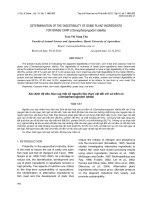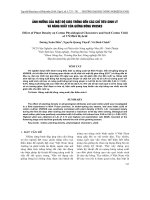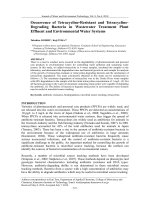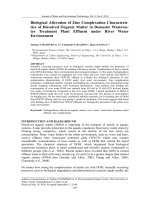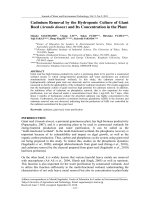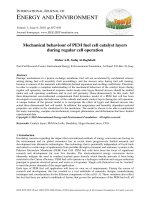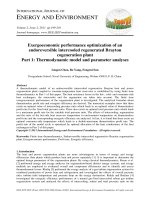Polyester plant normal operation document
Bạn đang xem bản rút gọn của tài liệu. Xem và tải ngay bản đầy đủ của tài liệu tại đây (929.26 KB, 17 trang )
Polyester:
Normal Operation of the plant
Content:
1. Additives
1.1 CPC Preparation
1.2 TiO Preparation
2. Raw Material Mixing
3. Esterification & process column
4. Postesterification
5. Prepolycondensation
6. Discage reactor
7. EG spray system
8. Vacuum system & stripper column
9. Capacity changes and throughput control
Content:
10. Plate Heat Exchanger Cleaning
11. Cleaning of Spray EG System (hotwells)
12. Vacuum measurements
1. Additives
CPC Preparation
Start CPC sequence in the night, so that the preparation vessel is already prefilled
if the morning shift starts.
Use the batch check-list to prevent mistakes
Keep the sequence running, only interfere in emergency cases
Keep the batch size constant
After CPC is filled into the preparation tank, bring next pallet of CPC to the
preparation area (ready on stock)
1. Additives
TiO Preparation
Start TiO sequence in the morning (relatively small amount of EG) for batch
preparation
Use the batch check-list to prevent mistakes
Keep the sequence running, only interfere in emergency cases
Keep sediment vessel 1 or sediment vessel 2 empty, if possible
Keep the batch size constant
Reject TiO from centrifuge once a month (accumulation of agglomerates)
After TiO is filled into the preparation tank, bring next pallet of TiO to the
preparation area (ready on stock)
2. Raw Material Mixing
Supervise the level in paste mixing tank and the mole ratio.
Keep the level in paste mixing tank as high as possible (mixing effect, hold-up
time)
Keep agitator speed always constant (30 rpm)
Check mole ratio once a day in the lab (sample taking)
Drifting of PTA balance has a great impact to esterification reaction
Check the paste pumps in the field requently (abnormal noise)
Open manhole of paste mixing vessel to get a feeling about the paste condition
Minimize the PTA dust entrainment into the process off-gas system by keeping
the spray EG at the dome of paste mixing vessel in operation
Keep nitrogen feed to paste mixing vessel (blanketing) in operation
3. Esterification and Process column
Keep temperature, esterification level, pressure and return EG (total mole ratio) as
stable as possible.
Check the level in HTM evaporator once per shift. If necessary, fill as slowly as
possible in order to prevent any temperature disturbance.
Keep level and temperature in process column stable. Level and temperature has
an influence on the formation of DEG.
Adjust column reflux so that no EG is leaving the system on top. The column top
temperature must correspond with the staturation temperature of water at a given
pressure.
4. Post-Esterification
Keep monomer feed to postester stable
Keep temperature, level and vacuum stable (influence of degree of esterification)
Remember: A higher temperature (quicker reaction), a lower level (less residence
time) or a lower (deeper) vacuum will change the degree of esterification
significantly
higher temperature = faster boiling = removal of EG
low level = less residence time = less time to build monomer
low vacuum = more EG is entrained
The higher the DE-%, the less the prepoly efficiency (due to less reactive end
groups) and this means a lower vacuum (more load) or higher prepoly reactor
temperature must be applied to reach the required viscosity for Discage inlet
5. Prepolycondensation
Keep monomer feed to prepoly stable
Keep temperature, level and vacuum stable (influence of degree of polycondens.)
The higher the DE-% of the monomer (in postesterification), the more the prepoly
reactor has to work, means to achieve the desired viscosity (IV) of about 0.3 dl/g,
a lower (deeper) vacuum in the prepoly has to be applied. This in turn will entrain
more oligomers leaving the reaction and collected in the hotwell.
The higher the applied temperature, the more by-products are formed
6. Discage reactor
Keep polymer feed to Discage reactor stable
Keep temperature, level and vacuum stable (influence of degree of polycondens.)
Vacuum will influence the viscosity extreamly.
Temperature will influence the formation of by-products such as aldehydes and
melt discolouration (yellowness)
Level will influence the residence time and thus the viscosity
Keep the agitator speed stable (changing the surface renewal and thus the melt
behaviour, reologie)
Remember: The higher the degree of polycondensation, the less end groups are
available, the lower (deeper) vacuum has to be applied. This in turn will entrain
more oligomers from the reaction.
7. EG spray system
Keep EG flow th process column stable. The higher the feed, the higher the
column load. Unstable EG flow to column changes column temperature profile.
Clean the hotwell baskets as soon as the low level alarm of the respective hotwell
appears in the DCS.
Clean the EG filter upstream the plate heat exchanger if the respective pressure
deviation alarm appears in the DCS.
Check the efficiency of the EG spray nozzles from the spray EG condensers once
a day (closing one spray nozzle, if pressure / flow remains same, nozzle could be
clogged).
8. Vacuum system & stripper column
Observe condensation temperature of the motive steam in the barometric leg of
the main vacuum condenser 24E51.
Temperature increasing in 24E51 shows less cooling efficiency resulting in less
condensation of motive steam due to fouling (oligomer settling down on the cold
surface condenser) resulting in worse vacuum.
Keep level in vacuum seal vessel and flow to stripper column constant.
Keep the air blower to stripper column always in operation to strip-out the low
boiling products from the process water.
9. Capacity Changes and Throughput Control
Capacity changes have always some minor effects on the product quality.
Changing the plant throughput stepwise over a longer time
Plant parameter are altered incrementally in small steps. The product quality can
be maintained. Disadvantageous is the required duration of a change over to a
new production capacity.
Changing the plant throughput in one go
Plant parameter are altered in one go. This strategy results in lower product
quality for some hours. The material has to be downgraded until the process is
stable again. This method is attractive if the necessary capacity change is so
large that it would take several days or if the capacity change can be combined
with the correction of some distrubance of with repair work.
10. Cleaning of Plate Heat Exchanger
Spent EG contains oligomers, which settle down at the surface of PHE.
Such oligomers reduces the heat transfer efficiency resulting in a higher partial
pressure of the low boilers dissolved in the spray EG (high partial pressure = low
boiling point). This results in an evaporation of such low boilers at higher
temperature and load the vacuum system, the vacuum in the reactors get worse.
Temperature control system compensates such temperature increase by opening
the control valve.
Clean and brush the plates thoroughly.
11. Cleaning of Spray EG System (hotwells)
Each hotwell contains several filter baskets, which removes bigger particles from
the spray EG.
Under normal process conditions, the installed filters and the hotwell filter baskets
perform their function and the spray nozzles remains free.
A poor operation procedure (removal of hotwell filter baskets without closing the
insert by a removable pipe) or a build-up of oligomers lumps in the spray
circulation system can still lead to a spray nozzle blockage.
As soon as the respective alarm appears in the DCS, remove one hotwell filter
basket and CLOSE THE INSERT WITH THE REMOVABLE PIPE . This
removable pipe avoid that unfiltered particles reach the spray nozzles and clog
them.
The baskets must be cleaned using high pressure water jet pump. Clean the
baskets thoroughly.
To assure the continuous operation (condensation of EG vapours from the
process), these spray nozzles must be cleaned regularly. Special care must be
taken to avoid a vacuum distrubance during this procedure.
In a blocked spray nozzle the spray EG can no longer properly atomized. A
blocked nozzle can be detected by closing the EG supply to this nozzle. Observe
the indication the flow meter / manometer. If no major change is detectable, it is
assumed that the nozzle is blocked.
For a clean nozzle the flow rate is reduced, when the supply to one of the spray
nozzles is interrupted.
Another possibility to detect a blocked nozzle:
If surface temperature of the pipe connection to the individual spray nozzles are
checked (touch by hand), there is a high potential of blocked spray nozzle, if
surface temperature is not as low as in the spray EG system (no condensation
drops, temperature close to ambient temperature).
12. Vacuum Measurements
At the measuring manifold from the prepoly and DISCAGE ® reactor a large
temperature difference develops between the instruments and the reactor content.
Vapour from the reactor would condense in the vacuum instruments, causing
measurement problems or even damaging the instrument if no nitrogen blanketing
is applied. Therefore make sure that always nitrogen blanketing to these
instruments located at the reactors manifold are ensured.
Even with the nitrogen blanketing, vacuum measurement can easily be disturbed.
If oligomer deposits line or clog the measuring manifold, a discrepancy between
the pressure measurement in the reactor and the indication on the instrument can
develop. Such discrepancies can create production problems.
To safeguard against such problems, the vacuum measurements of the
ESPREE® and DISCAGE® reactor must be checked at least once a day. A
special nozzle is foreseen at the measuring manifold to connect calibration
instruments. Make sure that, for mercury type calibration instruments, the mercury
is completely dry. Water or EG within the vacuum instruments leads to inaccurate
results!

